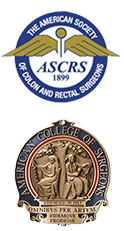Hemorrhoids
Hemorrhoids are cushions of vascular tissue found in and around the anal canal. Everyone is born with hemorrhoidal tissue that only becomes hemorrhoidal disease if symptoms occur. More than half the population will suffer from hemorrhoids at least once in their lifetime.
What are the risk factors for hemorrhoids?
- Constipation
- Diarrhea
- Straining during bowel movements
- Sitting on the toilet for long periods of time
- Pregnancy
- Aging
What are the symptoms of hemorrhoids?
There are two manifestations of hemorrhoidal disease. The external hemorrhoids are located under the skin at the anal opening. They can periodically swell and cause discomfort that subsides in a short period of time. If a patient suddenly develops a painful lump at the anus, the external hemorrhoid could have developed a clot or thrombosis. On occasion, the clot may erode through the skin causing bleeding not associated with a bowel movement.
The internal hemorrhoids are just inside the anus. They are typically not painful unless they protrude and become trapped outside the anal canal. The symptoms of internal hemorrhoids include bleeding, protrusion with defecation, and mucus discharge.
How are hemorrhoids diagnosed?
A full history and in-office examination, typically including anoscopy, by a colon and rectal surgeon will generally allow proper diagnosis of hemorrhoids. If rectal bleeding is one of the hemorrhoidal symptoms and the patient is over the age of 40, a colonoscopy may be advised.
How are hemorrhoids treated?
In the case of thrombosed external hemorrhoids, if the thrombosis is very large and painful excising the clot may be necessary and can be performed in the office. Mild symptomatic internal hemorrhoids can resolve with dietary and lifestyle changes. If constipation is the primary cause then a high fiber diet and more fluids can help. If diarrhea is the culprit, it is important to find the cause of the diarrhea and treat accordingly. Eliminating straining and sitting on the toilet for long periods of time often helps to prevent symptoms. Topical creams and ointments such as hydrocortisone may help alleviate symptoms. If these conservative interventions fail to improve symptoms, a formal evaluation and treatment of hemorrhoids by a colon and rectal surgeon either in the office or the operating room may we warranted.
Office-based Procedures.
These are often simple and painless techniques
- Sclerotherapy. A chemical solution such as phenol is injected into the internal hemorrhoid, where there are no nerves, to help shrink and fix the hemorrhoid back to where it anatomically belongs.
- Infra-red coagulation. The infra-red coagulation light penetrates the hemorrhoidal tissue and converts to heat to reduce the hemorrhoids.
- Rubber-band ligation. A small rubber band is place around the excess hemorrhoidal tissue. The blood vessels constrict causing the hemorrhoid to shrink and slough in a few days.
Surgical Procedures. There are some novel techniques in treating hemorrhoids that are much less painful than traditional surgery with a quicker recovery.
- Transanal Hemorrhoidal Dearterialization (THD). THD is a less traumatic and less invasive surgical treatment for hemorrhoids that has been shown to cause less pain and discomfort. It has been called “excision-less hemorrhoid surgery”. The THD technique is based on the closure of the hemorrhoidal blood flow through Doppler guidance as well as a suture pexy of the hemorrhoidal tissue back to its normal anatomical position.
- Procedure for Prolapsing Hemorrhoids (PPH). This procedure uses a special stapling device the removes a circular collar of excess hemorrhoidal tissue and fixates the remaining tissue back to its normal anatomical position.
- Traditional hemorrhoidectomy.





